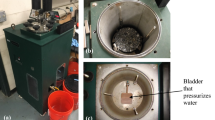Abstract
Moisture damage is one of the major problems that can be faced by a pavement during its service life. It can tremendously reduce a pavement’s strength and consequently its life. Moisture sensitivity testing of asphalt mixtures is critical for ensuring performance expectations are met. The objective of this paper is to illustrate the use of finite element modeling utilizing mechanistic test results to evaluate the moisture susceptibility and variability of mixtures. In this study, sixteen field procured laboratory compacted mixtures were used. The samples were divided into unconditioned and moisture conditioned samples. Dynamic modulus tests were performed on both moisture conditioned and unconditioned samples. The same samples were then used for flow number testing. The dynamic modulus results were used as input to a finite element model in which stochastic variation of the results were incorporated in the model. The model was validated by the results from the flow number test. The finite element analysis showed that the results’ variability increase with moisture conditioning and that moisture conditioned samples are more susceptible to rutting. Finite element model is a good tool to be combined with the dynamic modulus test to be able to evaluate the moisture susceptibility based on site conditions.
















Similar content being viewed by others
References
Ghanem R, Spanos P (1991) Stochastic finite elements: a spectral approach. Springer, New York
Zhou F, Scullion T (2003) Preliminary field validation of simple performance tests for permanent deformation: case study. Transportation Research Record 1832. Transportation Research Board, Washington, D.C., pp 209–216
Brown ER, Kandhal PS, Zhang J (2001) Performance testing for hot mix asphalt. Report 2001–05. National Center for Asphalt Technology (NCAT), Auburn
Collop AC, Scarpas A, Kasbergen C, De Bondt A (2003) Development and finite element implementation of stress-dependent elastoviscoplastic constitutive model with damage for asphalt. Transportation Research Record 1832. Transportation Research Board, Washington, D.C.
NCHRP (2004) Guide for mechanistic-empirical design of new and rehabilitated pavement structures. National Cooperative Highway Research Program, NCHRP 1-37A
Raad L, Figueroa JL (1980) Load response of transportation support systems. Transp Eng J (ASCE) 106(TE1):111–128
Little DN, Jones IV DR (2003) Chemical and mechanical processes of moisture damage in hot-mix asphalt pavements. In: Moisture sensitivity of asphalt pavements a national seminar, 4–6 Feb 2003
Owen DRJ, Hinton E (1980) Finite elements in plasticity: theory and practice. Pineridge Press Limited, Swansea
Lua YJ, Sues RH (1996) Probabilistic finite-element analysis of airfield pavement, Transportation Research Record 1540. Transportation Research Board, Washington, D.C., pp 29–38
ABAQUS (2009) ABAQUS version 6.9 reference manual. http://it.eng.iastate.edu:2080/v6.9/. Accessed 2 Nov 2009
Elseifi MA, Al-Qadi IL, Yoo PJ (2006) Viscoelastic modeling and field validation of flexible pavements. ASCE Journal of Engineering Mechanics 132(2):172–178
Williams ML, Landel RF, Ferry JD (1955) The temperature dependence of relaxation mechanism in amorphous polymers and other glass–liquids. J Am Chem Soc 77:370
Herzog M, Gilg A, Paffrath M, Rentrop P, Wever U (2007) Intrusive versus non-intrusive methods for stochastic finite elements. In: From nano to space. Springer, Berlin
Gubler R, Partl MN, Canestrari F, Grilli A (2005) Influence of water and temperature on mechanical properties of selected asphalt pavements. Mater Struct/Materiaux et Constructions 38(279):523–532
Lytton RL, Uzan EG, Femando R, Roque D, Hiltunen SM (1993) Development and validation of performance prediction models and specifications for asphalt binders and paving mixes, Strategic Highway Research Program 357. National Research Council, Washington, D.C.
Duncan JM, Monismith CL, Wilson EL (1968) Finite element analysis of pavements, Highway Research Record 228. Highway Research Board, Washington, D.C., pp 18–33
Harichandran RS, Baladi GY, Yeh M (1989) Development of a computer program for design of pavement systems consisting of bound and unbound materials. Department of Civil and Environmental Engineering, Michigan State University, Lansing
Witczak MW, Kaloush K, Pellinen T, El-Basyouny M, Von Quintus H (2002) Simple performance test for superpave mix design. National Cooperative Highway Research Program (NCHRP) Report 465
Roberts FL, Kandhal PS, Brown ER, Lee D, Kennedy TW (1996) Hot mix asphalt materials, mixture design, and construction, 2nd edn. National Asphalt Pavement Association Research and Education Foundation, Lanham
Papazian HS (1962) The response of linear viscoelastic materials in the frequency domain with emphasis on asphalt concrete. In: Proceedings of international conference on the structural design of asphalt pavements, Ann Arbor, pp 453–464
ASTM D3497-79 (2003) Standard test method for dynamic modulus of asphalt mixtures. Annual book of ASTM standards 4.03. ASTM International, West Conshohocken
Solaimanian M, Bonaquist RF, Tandon V (2007) Improved conditioning and testing for hma moisture susceptibility. National Cooperative Highway Research Program (NCHRP), Report 589, Washington, D.C.
Robinette C (2005) Testing Wisconsin asphalt mixtures for the 2002 AASHTO mechanistic design guide. Master Thesis, Michigan Technological University
Secor KE, Monismith CL (1961) Analysis of triaxial test data on asphalt concrete using viscoelastic principles. Highway Research Board Proceedings, Washington, D.C., vol 40, pp 295–314
Stolle D (2002) Pavement displacement sensitivity of layer moduli. Can Geotech J 39:2395-138
Santucci L (2002) Moisture sensitivity of asphalt pavements. Technology Transfer Program. UC-Berkley’s Institute of Transportation Studies, Berkley
Haldar A, Mahadevan S (2000) Probability, reliability, and statistical methods in engineering design. Wiley, New York
Schapery RA, Park SW (1999) Methods of Interconversion between Linear Viscoelastic Materials Functions. Part II – An Approximate Analytical Method. Int J Soils Struct 36(11):1677–1699
Author information
Authors and Affiliations
Corresponding author
Rights and permissions
About this article
Cite this article
Breakah, T.M., Williams, R.C. Stochastic finite element analysis of moisture damage in hot mix asphalt. Mater Struct 48, 93–106 (2015). https://doi.org/10.1617/s11527-013-0170-x
Received:
Accepted:
Published:
Issue Date:
DOI: https://doi.org/10.1617/s11527-013-0170-x



